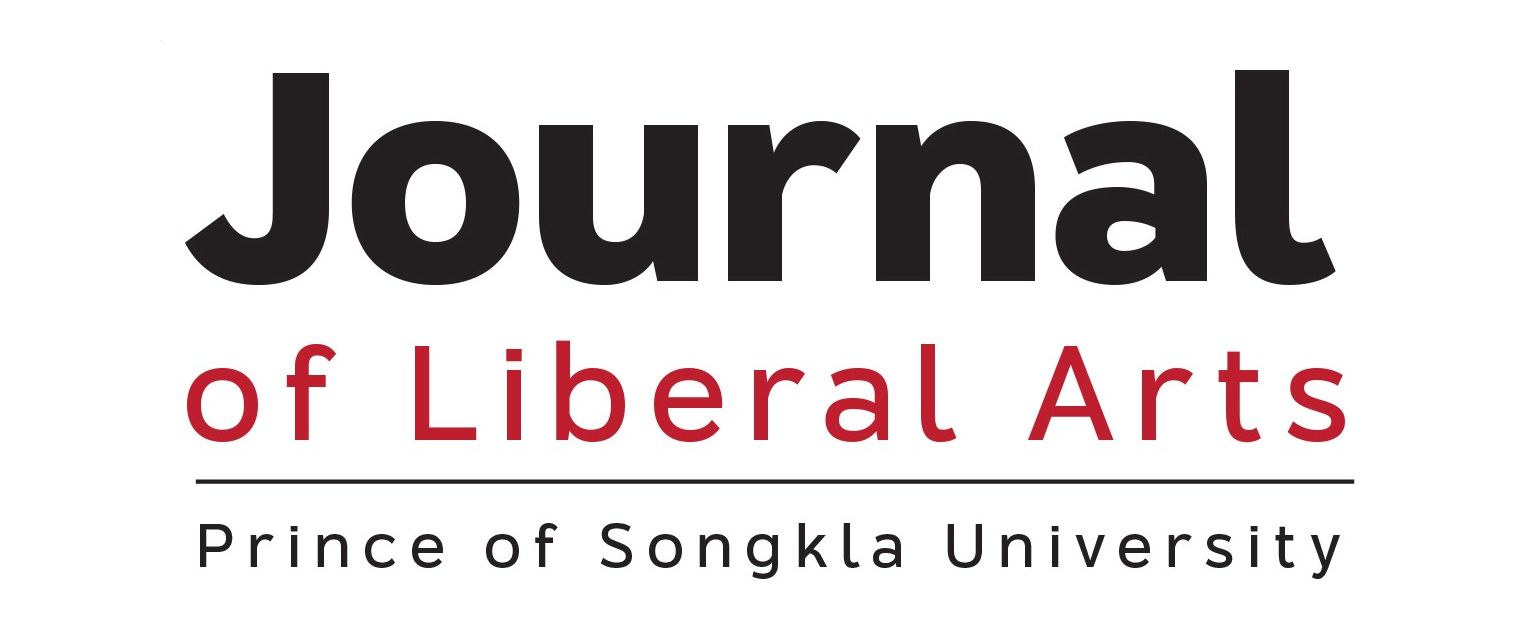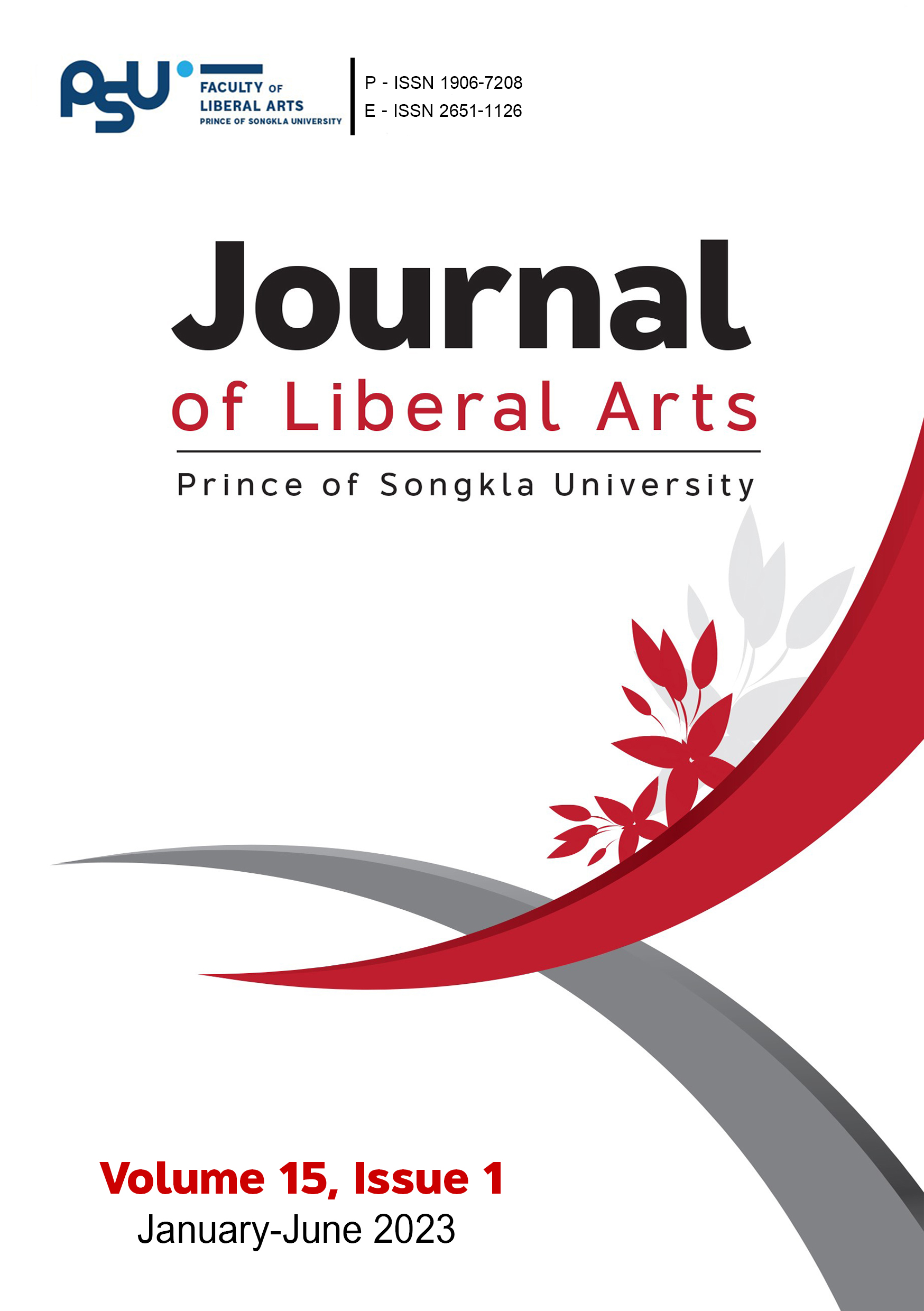จากวิดีโอคลิปขอโทษสู่การสนทนาบนสื่อดิจิตอล : การถอดรหัสวัจนกรรมของยูทูปเบอร์และความคิดเห็นของผู้ชม
DOI:
https://doi.org/10.14456/jlapsu.2023.9คำสำคัญ:
วัจนกรรมการขอโทษ , ยูทูปเบอร์ , การวิเคราะห์คอมเมนต์ , ประเภทของโทนบทคัดย่อ
งานวิจัยนี้มีวัตถุประสงค์ เพื่อศึกษากลวิธีการขอโทษในวิดีโอของยูทูปเบอร์ที่มีชื่อเสียงและศึกษาความสัมพันธ์ระหว่างกลวิธีการขอโทษกับความคิดเห็นของผู้ติดตามในคอมเมนต์ โดยเก็บข้อมูลวิดีโอจากช่องยูทูปของยูทูปเบอร์ที่มีชื่อเสียงจำนวน 8 คลิป และเก็บข้อมูลความคิดเห็นในคอมเมนต์ใต้คลิปที่ได้รับยอดไลค์มากที่สุด 10 อันดับแรกของแต่ละคลิป รวมทั้งสิ้น 80 คอมเมนต์ วิเคราะห์ข้อมูลกลวิธีการขอโทษโดยใช้แนวคิดกลวิธีการกล่าววัจนกรรมขอโทษของ Cohen and Olshtain (1981) ใช้วิธีการวิเคราะห์เนื้อหาของ Zhang (2016) ในการเข้ารหัส จัดกลุ่มและตีความหมายคอมเมนต์โดยใช้แนวคิดการตีความหมายความคิดเห็น (Tone interpretation) ของ Pearl and Steyvers (2013) ผลการวิจัยระบุว่ากลยุทธ์การขอโทษที่ยูทูปเบอร์ใช้มากที่สุด ได้แก่ การแสดงความรับผิดชอบ (Acknowledgement of responsibility) การแสดงความขอโทษ (Expression of apology) และการให้คำอธิบาย (Explanation or account) ในส่วนการวิเคราะห์ความคิดเห็นของผู้ติดตามในคอมเมนต์พบว่า สามารถแบ่งความคิดเห็นออกเป็น 2 กลุ่ม ได้แก่ ความคิดเห็นเชิงบวกและเชิงลบ โดยพบความคิดเห็นทั้งที่เป็นเชิงบวกและเชิงลบในวิดีโอบางส่วน อย่างไรก็ตาม ไม่พบความสัมพันธ์ที่มีนัยสำคัญระหว่างกลยุทธ์การขอโทษและทิศทางของความคิดเห็น ผลการศึกษานี้มีนัยยะสำคัญในการสร้างความเข้าใจเกี่ยวกับวิวัฒนาการของการกล่าววัจนกรรมขอโทษในยุคดิจิทัล และเสนอว่า ควรพิจารณาปัจจัยต่าง ๆ ที่อาจมีอิทธิพลต่อความคิดเห็นของผู้ติดตามต่อการขอโทษ เช่น ความรุนแรงของความผิด ความสนิทสนมระหว่างผู้ขอโทษและผู้รับคำขอโทษ หรืออำนาจของคู่สื่อสารแต่ละฝ่าย (CARLA, 2021)
เอกสารอ้างอิง
Abudin, B., & Sundari, H. (2021). Exploring apology strategy by Indonesian public figures: A pragmatic study in social media. DEIKSIS, 13 (2), 122-133.
Auxier, B., & Anderson, M. (2021, April 7). Social media use in 2021. Retrieved from https://www.pewresearch.org: https://
www.pewresearch.org/internet/2021/04/07/social-media-use-in-2021/
Bergman, M. L., & Kasper, G. (1991). The interlanguage of apologizing: Cross-cultural evidence. ESL, 2(10), 139-176.
CARLA. (2021). American English apologies. Retrieved May 1, 2023, from https://carla.umn.edu: https://carla.umn.edu/
speechacts/apologies/american.html
Cheng, D. (2013). Student instructor apologies: How are they preduced and percieved? [Doctoral Dissertation, Northern Arizona University].
Cohen, A. D., & Olshtain, E. (1981). Developing a measure of socio-cultural competence: The case of apology. Language Learning. 31(1), 113-133.
Dixon, S. (2023, February 13). Number of social media users worldwide from 2017 to 2027. Retrieved from www.statista.com:https://www.statista.com/statistics/278414/number-of-worldwide-social-network-users/#:~:text=In%202021%2C%20over%204.26%20billion,almost%20six%20billion%20in%202027.
Geyser, W. (2022, June 20). How to become a YouTuber – The ultimate checklist. Retrieved fromhttps://influencermarke
tinghub.com: https://influencermarketinghub.com/how-to-become-a-youtuber/
Grant, S., & Kim , S. G. (2020, January 28). 15 of YouTube's most horrifying scandals and controversies. Retrieved from https://www.seventeen.com/celebrity/movies-tv/g18753797/youtube-scandals-controversies/
Holmbom, M. (2015). The YouTuber : A qualitative study of popular content creators [Research Report]. Semantic Scholar. chrome-extension://efaidnbmnnnibpcajpcglclefindmkaj/http://umu.diva-portal.org/smash/get/diva2:825044/FULLTEXT01.pdf
Kakkar, A., & Samora, R. (2020). The aftermath of a YouTube apology. Retrieved from www.pudding.cool: https://pudding.cool/2020/01/apology/
Karlsson, G. (2020). The YouTube apology. [Master’s Thesis, Malmö University].
Loisa, J. (2021). "I’m just letting everyone know that I’m an idiot":Apology Strategies in YouTubers’ Apology Videos. [Master’s Thesis, University of Eastern Finland].
Morris, K., & Chiba, A. (2016, January 22). Descriptions of speech acts. carla.umn.edu: http://www.carla.umn.edu/speechacts/
descriptions.html
Pearl, L., & Steyvers, M. (2013). “C’mon – You Should Read This”: Automatic identification of tone from language text. International Journal of Computational Linguistics (IJCL), 4(1), 12-30.
Planalp, S. (1996). Communicating emotion in everyday life: Cues, channels, and processes. In P. A. Andersen, & L. K. Guerrero, Handbook of Communication and Emotion: Research, Theory, Applications, and Contexts (pp. 29-48). Academic Press.
S.L.Lai, L., & To, W. (2015). Content analysisof social media: A grounded theory approach. Journal of Electronic Commerce Research, May 2015, 138-152.
Sabilla, A., & Jusmaya, A. (2020). An analysis of apology strategies in the Ellen Degeneres show: Pragmatics Approach. Jurnal Ilmiah Mahasiswa, 2(3), 122-133.
Sandlin, J. K., & Gracyalny, M. L. (2018). Seeking sincerity, finding forgiveness: YouTube apologies as image repair. Public Relations Review, 44(3), 393-406.
Shepherd, J. (2023, February 23). 22 essential YouTube statistics you need to know in 2023. The Social Shepherd. https://thesocialshepherd.com/blog/youtube-statistics
Storms, R. (2022, March 13). Top 10 worst YouTubers of all time. TheTopTen. https://www.thetoptens.com/youtube/worst-youtubers/
Tastyedit. (2023, March 18). The biggest 2023 YouTube trends influencers need to know about. Tastyedits https://www
.tastyedits.com/biggest-youtube-trends-for-influencers/
YouTube. (2023, April 28). About YouTube. https://about.youtube/
Zhang, N. (2016). Public perceptions of genetically modified food on social media: A content analysis of Youtube comments on videos . [Master’s Thesis, University of South Carolina].
ดาวน์โหลด
เผยแพร่แล้ว
รูปแบบการอ้างอิง
ฉบับ
ประเภทบทความ
สัญญาอนุญาต
ลิขสิทธิ์ (c) 2023 Pitichon Muangkaew, Autsadee Poonkaew, Piyatida Idsa, Phrueksa Kaewgonnoi, Uraiwan Rattanapan Noonkong

อนุญาตภายใต้เงื่อนไข Creative Commons Attribution-NonCommercial-NoDerivatives 4.0 International License.
ลิขสิทธิ์บทความเป็นของผู้เขียน แต่วารสารศิลปศาสตร์ มหาวิทยาลัยสงขลานครินทร์ ขอสงวนสิทธิ์ในการเป็นผู้ตีพิมพ์เผยแพร่เป็นครั้งแรก






